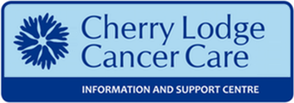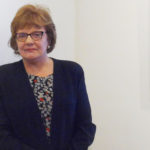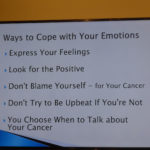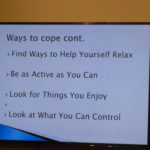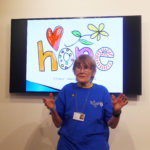As is customary, the Cherry Lodge Cancer Care AGM, held this year on Tuesday 15th May 2018, was followed by a short talk on a topic relating to the work of our charity.
This year’s speaker was Janet Doyle Blunden, a patron of Cherry Lodge, who has been involved with the charity since its beginning. Her many years’ experience as a nurse and manager, specialising in oncology and palliative care, made her the ideal person to talk to us about ‘Finding Hope on the Journey through Cancer’.
Janet began by asking her audience to consider the value of Cherry Lodge – and it was quite clear that everyone agreed that CL is priceless, that it is impossible to put a figure on it. She then explained why she became interested in cancer care and how much things have changed since she first became a nurse. In the 1970s, it was common for patients never to be told that they had cancer and it was generally believed that the person who held the key to hope was the physician. During the 1980s and 1990s there was a shift towards a partnership between professionals and service users and a realisation that professionals needed to listen more to their patients.
A few of Janet’s main themes will be touched on here, starting with the question “What is hope?”, which she acknowledged is a difficult one. Hope can be defined as being open to possibilities and having confidence in the future no matter how long or short – but different people may have very different hopes in the face of serious illness. Hopes might be small, such as being able to get up for breakfast, or large, like being well enough to attend a big family event. Helping foster hope is of huge importance. We need to be alert to other people’s stories and to acknowledge their individual hopes and fears.
To understand hope it is necessary to know something about hopelessness. When faced with hopelessness, we need to find coping strategies to allow hope to return. It is also useful to recognise that our worst fears aren’t always realised – in the words of Mark Twain: “I’ve lived through some terrible things in my life, some of which actually happened”.
Hope lives in different places. For some people, hope comes from within. For others, it is drawn from something external, such as studying blood results, a treatment regime or hospital appointments. Often, internal and external elements are combined. Some people cope through blind faith, while others attempt to control everything. Again, most people combine the two.
Cancer survivorship is quite a new concept. Many more people now survive for much longer after a diagnosis of cancer. Members of the audience were asked to talk to a neighbour and then share their thoughts. Margaret Clark expressed the importance of never taking away people’s hope. For Colin, hope is what you build up before treatment or when you get better, for example by coming to Cherry Lodge to talk to the nurses and meeting other people who have come through cancer. Following chemotherapy, Peter drew strength and hope from being in touch with nature, sitting in the garden.
Janet returned to the theme of partnership between people affected by cancer and the professionals who treat them. She also emphasised the need always to recognise the views of the individual, giving as an example Mary, aged 91, who insisted on travelling miles to receive more treatment when her family thought this would be too gruelling for her. Afterwards, they were forced to admit: “Well she was right and we were all wrong – it was my fears not hers!” The treatment had worked and hope had prevailed.
After a most enlightening session, Janet was thanked by Margaret and given a splendid orchid by Kirsty on behalf of Cherry Lodge.
Click on the small images below to see larger, complete photographs.
